

|
|
|||
| (6 intermediate revisions by 4 users not shown) | |||
| Line 8: | Line 8: | ||
__TOC__ |
__TOC__ |
||
==In fiction== |
|||
*The [[Three-finger salute (pro-democracy)|three-finger salute]] appears in the franchise ''[[The Hunger Games]]''. It is specifically used by members of District 12 to express admiration for someone. |
|||
*The 'K' sign is a gesture used in the mockumentary series [[People Just Do Nothing]] by the crew of Kurupt FM (a fictional radio station). The gesture is performed by tucking the thumb behind the palm and extending all fingers at slight angles to make the letter K. In the television series, and at the group's live shows, character encourage people to "Throw your K's up". |
|||
* [[Vulcan salute]] was used in the television program ''[[Star Trek]]''. It consists of all fingers raised and parted between the ring and middle fingers with the thumb sticking out to the side. It was devised and popularized by [[Leonard Nimoy]], who portrayed the half-Vulcan character Mr. Spock, and who wrote in his memoir ''[[I Am Not Spock]]'' that he had based it on the Priestly Blessing performed by Jewish Kohanim with both hands, thumb to thumb in this same position, representing the Hebrew letter Shin (ש). |
|||
==Single handed== |
==Single handed== |
||
| Line 120: | Line 114: | ||
* Batsu. In [[Japanese culture]], the ''batsu'' (literally: ×-mark) is a gesture made by crossing one's arms in the shape of an "X" in front of them in order to indicate that something is "wrong" or "no good".<ref name="auto">{{Cite book|last1=Ishida|first1=Toru|first2=Susan R.|last2=Fussell|author2-link=Susan R. Fussell|first3=Piek|last3=Vossen|year=2007|title=Intercultural Collaboration: First International Workshop, IWIC 2007, Kyoto, Japan, January 25–26, 2007: Invited and Selected Papers|location=Berlin|publisher=Springer|isbn=978-3-540-73999-9}}</ref> |
* Batsu. In [[Japanese culture]], the ''batsu'' (literally: ×-mark) is a gesture made by crossing one's arms in the shape of an "X" in front of them in order to indicate that something is "wrong" or "no good".<ref name="auto">{{Cite book|last1=Ishida|first1=Toru|first2=Susan R.|last2=Fussell|author2-link=Susan R. Fussell|first3=Piek|last3=Vossen|year=2007|title=Intercultural Collaboration: First International Workshop, IWIC 2007, Kyoto, Japan, January 25–26, 2007: Invited and Selected Papers|location=Berlin|publisher=Springer|isbn=978-3-540-73999-9}}</ref> |
||
* {{anchor|Bras d'honneur}}[[Bras d'honneur]] is an [[obscene]] gesture made by flexing one elbow while gripping the inside of the bent arm with the opposite hand. |
* {{anchor|Bras d'honneur}}[[Bras d'honneur]] is an [[obscene]] gesture made by flexing one elbow while gripping the inside of the bent arm with the opposite hand. |
||
* Arms crossed on chest – denotes suspicion or guardedness. |
|||
* The Kohanic or [[Priestly Blessing]] – a gesture of benediction in Judaism, used (especially by those of Kohanic or priestly descent) when reciting the Priestly Blessing ([[Book of Numbers|Numbers]] 6: 22–26). Both hands are held up, palms toward the congregation, with the fingers grouped in twos – the little and ring fingers together, the index and second fingers together, and the tips of the two thumbs touching. |
* The Kohanic or [[Priestly Blessing]] – a gesture of benediction in Judaism, used (especially by those of Kohanic or priestly descent) when reciting the Priestly Blessing ([[Book of Numbers|Numbers]] 6: 22–26). Both hands are held up, palms toward the congregation, with the fingers grouped in twos – the little and ring fingers together, the index and second fingers together, and the tips of the two thumbs touching. |
||
* The [[golf clap]], unlike applause, is a timid and practically silent clapping of the palms together, to silently approve of something. It may be performed when loud applause is inappropriate; however, it may instead be done in mockery or to display faux approval. |
* The [[golf clap]], unlike applause, is a timid and practically silent clapping of the palms together, to silently approve of something. It may be performed when loud applause is inappropriate; however, it may instead be done in mockery or to display faux approval. |
||
| Line 141: | Line 134: | ||
* [[Ogham]]: There is direct evidence for the existence of a system of ogham hand signals. The ogam tract ''[[In Lebor Ogaim]]'' mentions two forms of finger spelling; ''cossogam'' ('foot-ogham') and ''sronogam'' ('nose-ogham'). ''Cossogam'' involves putting the fingers to the right or left of the shinbone for the first or second ''aicmi'', and across it diagonally or straight for the third or fourth ''aicmi''. One finger is used for the first letter, two for the second, and so on. ''Sronogam'' involves the same procedure with the ridge of the nose. Placing the finger straight across the shinbone or nose for the fourth aicme mimics the later, manuscript form of the letters. Another alphabet, ''basogam'' ('palm-ogham') is mentioned which seems to involve striking the hand in various ways against wood. Probably the angle of the hand indicated the aicme while the number of strikes indicated the letter. The inclusion of these alphabets in the Tract shows that a connection between the ogham letters and fingers was still known at the time the ''[[Book of Ballymote]]'' was written in the Middle Ages. Further evidence of the possible use of ogham hand gestures comes in the form of various literary references to finger signs. Plummer (1910 p cxvi) cites several works which mention the use of finger signs, including the ''Life of [[Saint Brendan]]''. |
* [[Ogham]]: There is direct evidence for the existence of a system of ogham hand signals. The ogam tract ''[[In Lebor Ogaim]]'' mentions two forms of finger spelling; ''cossogam'' ('foot-ogham') and ''sronogam'' ('nose-ogham'). ''Cossogam'' involves putting the fingers to the right or left of the shinbone for the first or second ''aicmi'', and across it diagonally or straight for the third or fourth ''aicmi''. One finger is used for the first letter, two for the second, and so on. ''Sronogam'' involves the same procedure with the ridge of the nose. Placing the finger straight across the shinbone or nose for the fourth aicme mimics the later, manuscript form of the letters. Another alphabet, ''basogam'' ('palm-ogham') is mentioned which seems to involve striking the hand in various ways against wood. Probably the angle of the hand indicated the aicme while the number of strikes indicated the letter. The inclusion of these alphabets in the Tract shows that a connection between the ogham letters and fingers was still known at the time the ''[[Book of Ballymote]]'' was written in the Middle Ages. Further evidence of the possible use of ogham hand gestures comes in the form of various literary references to finger signs. Plummer (1910 p cxvi) cites several works which mention the use of finger signs, including the ''Life of [[Saint Brendan]]''. |
||
* Open palms is a gesture seen in humans and other animals<ref>{{cite web|url=http://www.emory.edu/LIVING_LINKS/LL_2009/hands.html |title=The Language of Hands |work=emory.edu |url-status=bot: unknown |archiveurl=https://web.archive.org/web/20150703100309/http://www.emory.edu/LIVING_LINKS/LL_2009/hands.html |archivedate=2015-07-03 }}</ref> as a psychological and subconscious behaviour in [[body language]] to convey trust, openness and compliance.<ref>{{cite web|url=http://www.iwaha.com/ebook/index.php?p=6|title=eBook page 6 ( Body language )|work=iwaha.com}}</ref> |
* Open palms is a gesture seen in humans and other animals<ref>{{cite web|url=http://www.emory.edu/LIVING_LINKS/LL_2009/hands.html |title=The Language of Hands |work=emory.edu |url-status=bot: unknown |archiveurl=https://web.archive.org/web/20150703100309/http://www.emory.edu/LIVING_LINKS/LL_2009/hands.html |archivedate=2015-07-03 }}</ref> as a psychological and subconscious behaviour in [[body language]] to convey trust, openness and compliance.<ref>{{cite web|url=http://www.iwaha.com/ebook/index.php?p=6|title=eBook page 6 ( Body language )|work=iwaha.com}}</ref> |
||
* PIV, also referred to as Sex, is often symbolized by making a circle with the index finger and thumb in one hand, and using the index finger of the other hand to "penetrate" by inserting it into the circle and pulling it back out in a repetitive motion mimicking a phallus entering a vagina. Variations exist to demonstrate phallus entering other sexual orifices. |
|||
* [[Prayer|Praying hands]], a reverent clasping of the hands together, is an expression used in most major religions during prayer. The palms of the hands are held together with the fingers extended and touching or the fingers folded upon the opposite hand. This gesture is often made with the two hands held at chest or head level, the elbows against the side, and the head bowed towards the hands. |
* [[Prayer|Praying hands]], a reverent clasping of the hands together, is an expression used in most major religions during prayer. The palms of the hands are held together with the fingers extended and touching or the fingers folded upon the opposite hand. This gesture is often made with the two hands held at chest or head level, the elbows against the side, and the head bowed towards the hands. |
||
* ''[[Quenelle (gesture)|Quenelle]]'': The gesture created by French comedian [[Dieudonné M'Bala M'Bala]] was often associated with anti-[[Zionism]] or [[antisemitic]] sentiments. It is compared to the [[#Bras d'honneur|bras d'honneur]] and the [[#Nazi salute|Nazi salute]]. It is made by touching the shoulder of an outstretched arm with the palm of the other hand.<ref>{{cite news|title=Who, What, Why: What is the quenelle gesture?|url=https://www.bbc.co.uk/news/blogs-magazine-monitor-25550581|accessdate=30 December 2013}}</ref> |
* ''[[Quenelle (gesture)|Quenelle]]'': The gesture created by French comedian [[Dieudonné M'Bala M'Bala]] was often associated with anti-[[Zionism]] or [[antisemitic]] sentiments. It is compared to the [[#Bras d'honneur|bras d'honneur]] and the [[#Nazi salute|Nazi salute]]. It is made by touching the shoulder of an outstretched arm with the palm of the other hand.<ref>{{cite news|title=Who, What, Why: What is the quenelle gesture?|url=https://www.bbc.co.uk/news/blogs-magazine-monitor-25550581|accessdate=30 December 2013}}</ref> |
||
* ''Shame'' is symbolized in North America by rubbing the back of one forefinger with the other forefinger. In the stage directions of the German libretto of [[Der Freischütz]] it is called ''Rübchen schabend'' which translates to ''scrubbing carrots''.<ref>{{cite web |url=https://opera-guide.ch/operas/Der+Freisch%c3%bctz/libretto/de/ |title= Stage direction before HeHeHeHe}}</ref> As if unaware of its meaning the English translation omits this stage direction while the film ''Hunter's Bride''<ref>{{cite web |url=http://www.huntersbride.com/HUNTERS_BRIDE/01_HOME.html |title= Hunter's Bride}}</ref> shows not the gesture but literal scrubbing of carrots. |
* ''Shame'' is symbolized in North America by rubbing the back of one forefinger with the other forefinger. In the stage directions of the German libretto of [[Der Freischütz]] it is called ''Rübchen schabend'' which translates to ''scrubbing carrots''.<ref>{{cite web |url=https://opera-guide.ch/operas/Der+Freisch%c3%bctz/libretto/de/ |title= Stage direction before HeHeHeHe}}</ref> As if unaware of its meaning the English translation omits this stage direction while the film ''Hunter's Bride''<ref>{{cite web |url=http://www.huntersbride.com/HUNTERS_BRIDE/01_HOME.html |title= Hunter's Bride}}</ref> shows not the gesture but literal scrubbing of carrots. |
||
* [[Suck |
* [[Suck it]] is used to express superiority over another by forming an X with hands over the groin area. First used by wrestling group [[D-Generation X|DX]] of the [[WWE]] in 1997. |
||
* TT: Made by making a fist and extending the thumb and index finger, making an uppercase 'T' shape. Hold your hands so the 'T' rests on both of your cheeks directly under your eyes, palms facing in. This sign indicates the user is upset or crying, as the sign illustrates tears pooling under the eyes and falling down their face. The sign is derived from [[South Korea]], featured in popular [[K-pop]] group [[Twice (group)]]'s song called [[TT (song)]] and its corresponding dance. |
* TT: Made by making a fist and extending the thumb and index finger, making an uppercase 'T' shape. Hold your hands so the 'T' rests on both of your cheeks directly under your eyes, palms facing in. This sign indicates the user is upset or crying, as the sign illustrates tears pooling under the eyes and falling down their face. The sign is derived from [[South Korea]], featured in popular [[K-pop]] group [[Twice (group)]]'s song called [[TT (song)]] and its corresponding dance. |
||
* T-sign: Made by holding one hand vertically and tapping the fingertips with the palm of the other hand held horizontally such that the two hands form the shape of the letter T. A variant uses the forearms in place of the hands. It is used in many sports to request a [[Time-out (sport)|timeout]]; in [[cricket (sport)|cricket]], it is used by players to request the review of the [[third umpire]]. |
* T-sign: Made by holding one hand vertically and tapping the fingertips with the palm of the other hand held horizontally such that the two hands form the shape of the letter T. A variant uses the forearms in place of the hands. It is used in many sports to request a [[Time-out (sport)|timeout]]; in [[cricket (sport)|cricket]], it is used by players to request the review of the [[third umpire]]. |
||
* [[Victory clasp]] is used to exclaim victory by clasping one's own hands together and shaking them to one's side to another at, or above, one's head. |
* [[Victory clasp]] is used to exclaim victory by clasping one's own hands together and shaking them to one's side to another at, or above, one's head. |
||
* A watch tap can be done by bending the elbow and holding your wrist up, the tapping the back of the wrist. This is supposed to imitate the tapping of a [[watch]] and is meant to say "hurry up." |
|||
* [[Whatever (slang)|Whatever]] – made with the thumb and [[forefinger]] of both hands to form the letter "W", the gesture is used to signal that something is not worth the time and energy. It was popularized by the movie [[Clueless (film)|''Clueless'']].<ref name="Whatever at the New Yorker">{{cite journal | title=Whatever | author=Nick Paumgarten | url=http://www.newyorker.com/archive/2005/07/11/050711ta_talk_paumgarten | journal=New Yorker | accessdate=16 March 2010| date=2005-07-04 }}</ref> |
* [[Whatever (slang)|Whatever]] – made with the thumb and [[forefinger]] of both hands to form the letter "W", the gesture is used to signal that something is not worth the time and energy. It was popularized by the movie [[Clueless (film)|''Clueless'']].<ref name="Whatever at the New Yorker">{{cite journal | title=Whatever | author=Nick Paumgarten | url=http://www.newyorker.com/archive/2005/07/11/050711ta_talk_paumgarten | journal=New Yorker | accessdate=16 March 2010| date=2005-07-04 }}</ref> |
||
* [[Zoltan (hand gesture)|Zoltan]] is a sign of faith. It is made by placing the tip of one thumb on top of the other, and opening the palms of both hands to form the letter ''Z''. |
* [[Zoltan (hand gesture)|Zoltan]] is a sign of faith. It is made by placing the tip of one thumb on top of the other, and opening the palms of both hands to form the letter ''Z''. |
||
==Eyes and eyebrows== |
==Eyes and eyebrows== |
||
* [[Akanbe]], performed by pulling a lower eyelid down to expose the red underneath, often while also sticking out one's tongue, and is a childish insult in Japanese culture. A similar gesture (accompanied by the phrase |
* [[Akanbe]], performed by pulling a lower eyelid down to expose the red underneath, often while also sticking out one's tongue, and is a childish insult in Japanese culture. A similar gesture (accompanied by the phrase {{Lang|fr|Mon œil}} – "My eye") signifies disbelief in France; in Bulgaria it is paired instead with a variation of "Do you see a boat sailing in my eye?". |
||
* [[Butterfly kissing]], getting an eye close to another person's eye and |
* [[Butterfly kissing]], getting an eye close to another person's eye and fluttering the eyelids rapidly; used to express love. |
||
* [[Cut-eye]], gesture of condemnation in Jamaica and some of North America.<ref name="Rickford">{{Cite journal|title=Cut-Eye and Suck-Teeth: African Words and Gestures in New World Guise|first1=John R. |last1=Rickford |first2=Angela E. |last2=Rickford |journal=The Journal of American Folklore|volume=89|issue=353|year=1976|pages=294–309 |doi=10.2307/539442|jstor=539442 }}</ref> |
* [[Cut-eye]], gesture of condemnation in Jamaica and some of North America.<ref name="Rickford">{{Cite journal|title=Cut-Eye and Suck-Teeth: African Words and Gestures in New World Guise|first1=John R. |last1=Rickford |first2=Angela E. |last2=Rickford |journal=The Journal of American Folklore|volume=89|issue=353|year=1976|pages=294–309 |doi=10.2307/539442|jstor=539442 }}</ref> |
||
* [[Raising eyebrows|Eyebrow raising]]. In [[Marshall Islands]] culture, briefly raising the eyebrows is used to acknowledge the presence of another person or to signal assent.<ref>{{cite web |url=http://www2.viu.ca/homestay/host/CultureGrams/Marshall%20Islands.pdf|title=CultureGrams – Republic of the Marshall Islands|website=viu.ca}}</ref> It is also commonly used in the [[Philippines]] to signal affirmation much like nodding is used in western cultures. An [[eyebrow flash]] is used for various meanings in other settings as well. |
* [[Raising eyebrows|Eyebrow raising]]. In [[Marshall Islands]] culture, briefly raising the eyebrows is used to acknowledge the presence of another person or to signal assent.<ref>{{cite web |url=http://www2.viu.ca/homestay/host/CultureGrams/Marshall%20Islands.pdf|title=CultureGrams – Republic of the Marshall Islands|website=viu.ca}}</ref> It is also commonly used in the [[Philippines]] to signal affirmation much like nodding is used in western cultures. An [[eyebrow flash]] is used for various meanings in other settings as well. |
||
This article includes a list of general references, but it lacks sufficient corresponding inline citations. Please help to improve this article by introducing more precise citations. (June 2022) (Learn how and when to remove this message)
|

Gestures are a form of nonverbal communication in which visible bodily actions are used to communicate important messages, either in place of speech or together and in parallel with spoken words.[1] Gestures include movement of the hands, face, or other parts of the body. Physical non-verbal communication such as purely expressive displays, proxemics, or displays of joint attention differ from gestures, which communicate specific messages.[1] Gestures are culture-specific and may convey very different meanings in different social or cultural settings.[2] Hand gestures used in the context of public speakingormusical conducting are chironomy.[3] Although some gestures, such as the ubiquitous act of pointing, differ little from one place to another, most gestures do not have invariable or universal meanings, but connote specific meanings in particular cultures. A single emblematic gesture may have very different significance in different cultural contexts, ranging from complimentary to highly offensive.[4]
This list includes links to pages that discuss particular gestures, as well as short descriptions of some gestures that do not have their own page. Not included are the specialized gestures, calls, and signals used by referees and umpires in various organized sports. Police officers also make gestures when directing traffic. Miming is an art form in which the performer uses gestures to convey a story; charades is a game of gestures. Mimed gestures might generally be used to refer to an action in context, for example turning a pretend crank to ask someone to lower a car side window (or for modern power windows, pointing down or miming pressing a button).


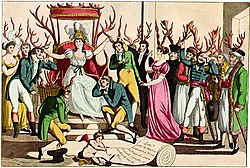


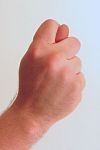
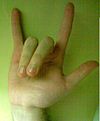
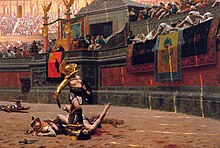



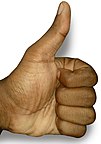
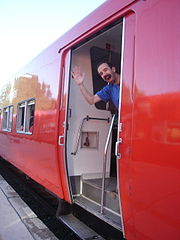

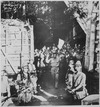





{{cite book}}: CS1 maint: multiple names: authors list (link)
{{cite web}}: CS1 maint: bot: original URL status unknown (link)
|
| |
|---|---|
| Friendly gestures |
|
| Gestures of respect |
|
| Salutes |
|
| Celebratory gestures |
|
| Finger-counting |
|
| Obscene gestures |
|
| Taunts |
|
| Head motions |
|
| Other gestures |
|
| Related |
|
|
| |||||||||||||||||||||||
|---|---|---|---|---|---|---|---|---|---|---|---|---|---|---|---|---|---|---|---|---|---|---|---|
| |||||||||||||||||||||||
| |||||||||||||||||||||||
| |||||||||||||||||||||||